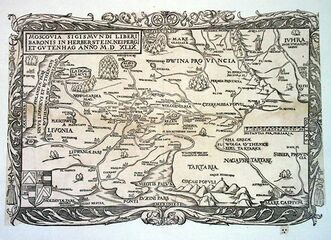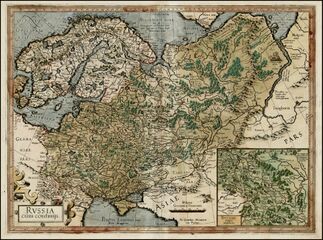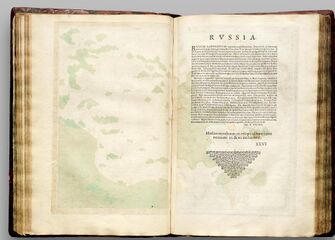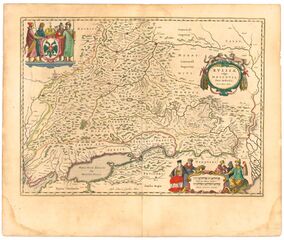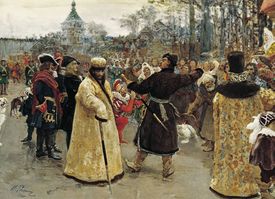قيصرية روسيا
Tsardom of Russia Русское царство Russkoye tsarstvo | |||||||||||||||||||
|---|---|---|---|---|---|---|---|---|---|---|---|---|---|---|---|---|---|---|---|
| 1547–1721 | |||||||||||||||||||
[[List of Russian flags|Flag of the Tsar
(ح. 1693)]] | |||||||||||||||||||
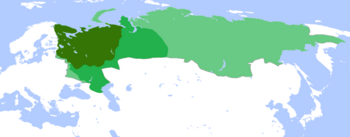 Territory of Russia in 1500, 1600 and 1689 | |||||||||||||||||||
| العاصمة | Moscow (1547–1712) Saint Petersburg (1712–1721) | ||||||||||||||||||
| اللغات الشائعة | Russian (official) | ||||||||||||||||||
| الدين | Russian Orthodox (official) | ||||||||||||||||||
| الحكومة | Absolute monarchy | ||||||||||||||||||
| Tsar | |||||||||||||||||||
• 1547–1584 | Ivan IV (first) | ||||||||||||||||||
• 1682–1721 | Peter I (last) | ||||||||||||||||||
| التشريع | Boyar Duma (1547–1549; 1684–1711) Zemsky Sobor (1549–1684) Governing Senate (1711–1721) | ||||||||||||||||||
| التاريخ | |||||||||||||||||||
• Coronation of Ivan IV | 16 January 1547 | ||||||||||||||||||
| 1558–1583 | |||||||||||||||||||
| 1598–1613 | |||||||||||||||||||
| 1654–1667 | |||||||||||||||||||
| 1700–1721 | |||||||||||||||||||
| 10 September 1721 | |||||||||||||||||||
| 22 October 1721 | |||||||||||||||||||
| التعداد | |||||||||||||||||||
• 1500[1] | 6 million | ||||||||||||||||||
• 1600[1] | 12 million | ||||||||||||||||||
• 1646[2] | 14 million | ||||||||||||||||||
• 1719[3] | 15.7 million | ||||||||||||||||||
| Currency | Russian ruble | ||||||||||||||||||
| |||||||||||||||||||
| Today part of | Belarus Finland Russia Ukraine | ||||||||||||||||||
قيصرية روسيا أو قيصرية روس' (روسية: Русское царство, romanized: Russkoye tsarstvo,[4][5] لاحقاً تغيرت إلى: Российское царство, Rossiyskoye tsarstvo),[6][7] كما يشار إليها من الخارج بإسم قيصرية موسكوڤي،[8][9] كانت الدولة الروسية المركزية من افتراض أن لقب "قيصر" الذي حمله إيڤان الرابع في 1547 وحتى تأسيس الامبراطورية الروسية على يد پطرس الأول في 1721.
لا يمكننا بصدق أن نطلق على البلد الناشئ إلى الشمال الشرقي من كييڤ اسم "قيصرية روس" (بالروسية: Царство Русское). الاسم الأكثر مناسبة هو موسكوڤي. فبالرغم من أن قياصرة موسكو في بعض المناسبات أشاروا إلى أنفسهم, حين كانوا يقابلون وفوداً أجنبية, بلقب قيصر كل الروس Tsar of all Rus'; إلا أن ذلك سيكون مطاً للحقيقة. فلب أراضي روس كييڤ السابقة ذهبت للغرب, فطرق التجارة التي كانت السلوك المميز لدولة روس انهارت جميعها, ونظام حكومة موسكوڤيكان مختلفاً تماماً, وكدولة منغلقة تماماً وأوتوقراطية, موسكوڤي, لم يكن لديها حتى جزءاً يسيراً من الصلات والأبهة التي كان يتمتع بها أمراء كييڤ في الغرب والجنوب. الاسم روسيا كإسم رسمي للبلد لم يظهر للوجود حتى عهد بطرس الأكبر.
بالرغم من ذلك, لما كانت الأراضي المحيطة بموسكو في تلك الفترة قد توحدت في دولة واحدة ذات سيادة, فإن اسم "قيصرية روسيا" يشيع استعماله.
الاسم
While the oldest endonyms of the Grand Duchy of Moscow used in its documents were "Rus'" (Русь) and the "Russian land" (Русская земля, Russkaya zemlya),[10] a new form of its name, Rusia or Russia, appeared and became common in the 15th century.[11][12][13] In the 1480s Russian state scribes Ivan Cherny and Mikhail Medovartsev mention Russia under the name Росиа, Rosia, and Medovartsev also mentions the sceptre "of Russian lordship" (Росийскаго господства, Rosiyskago gospodstva).[14] In the following century Russia co-existed with the old name Rus' and appeared in an inscription on the western portal of the Transfiguration Cathedral of the Spaso-Preobrazhensky Monastery in Yaroslavl (1515), on the icon case of the Theotokos of Vladimir (1514), in the work by Maximus the Greek,[15] the Russian Chronograph written by Dosifei Toporkov (?–1543/44[16]) in 1516–22 and in other sources.[17]
In 1547, Ivan IV assumed the title of “Tsar and Grand Duke of all Rus'” (Царь и Великий князь всея Руси, Tsar i Velikiy knyaz vseya Rusi) and was crowned on 16 January,[18] thereby turning the Grand Duchy of Moscow into Tsardom of Russia, or "the Great Russian Tsardom", as it was called in the coronation document,[19] by Constantinople Patriarch Jeremiah II[20][21] and in numerous official texts,[22][23][24][25][26][27] but the state partly remained referred to as Moscovia (قالب:Lang-eng) throughout Europe, predominantly in its Catholic part, though this Latin term was never used in Russia.[28] The two names Russia and Moscovia appear to have co-existed as interchangeable during the later 16th and throughout the 17th century with different Western maps and sources using different names, so that the country was called "Russia, or Moscovia" (لاتينية: Russia seu Moscovia) or "Russia, popularly known as Moscovia" (لاتينية: Russia vulgo Moscovia). In England of the 16th century, it was known both as Russia and Muscovy.[29][30] Such notable Englishmen as Giles Fletcher, author of the book Of the Russe Common Wealth (1591), and Samuel Collins, author of The Present State of Russia (1668), both of whom visited Russia, were familiar with the term Russia and used it in their works.[31] So did numerous other authors, including John Milton, who wrote A brief history of Moscovia and of other less-known countries lying eastward of Russia, published posthumously,[32] starting it with the words: "The Empire of Moscovia, or as others call it, Russia..."[33]
In the Russian Tsardom, the word Russia replaced the old name Rus' in official documents, though the names Rus' and Russian land were still common and synonymous to it,[34] and often appeared in the form Great Russia (Великая Россия, Velikaya Rossiya), which is more typical of the 17th century,[35] whereas the state was also known as Great-Russian Tsardom (Великороссийское царствие, Velikorossiyskoye tsarstviye).[22]
According to prominent historians like Alexander Zimin and Anna Khoroshkevich, the continuous use of the term Moscovia was a result of traditional habit and the need to distinguish between the Muscovite and the Lithuanian part of the Rus', as well as of the political interests of the Polish–Lithuanian Commonwealth, which competed with Moscow for the western regions of Rus'. Due to the propaganda of the Commonwealth,[36][37] as well as of the Jesuits, the term Moscovia was used instead of Russia in many parts of Europe where prior to the reign of Peter the Great there was a lack of direct knowledge of the country. In Northern Europe and at the court of the Holy Roman Empire, however, the country was known under its own name, Russia or Rossia.[38] Sigismund von Herberstein, ambassador of the Holy Roman Emperor in Russia, used both Russia and Moscovia in his work on the Russian tsardom and noted: "The majority believes that Russia is a changed name of Roxolania. Muscovites ("Russians" in the German version) refute this, saying that their country was originally called Russia (Rosseia)".[39] Pointing to the difference between Latin and Russian names, French captain Jacques Margeret, who served in Russia and left a detailed description of L’Empire de Russie of the early 17th century that was presented to King Henry IV, stated that foreigners make "a mistake when they call them Muscovites and not Russians. When they are asked what nation they are, they respond 'Russac', which means 'Russians', and when they are asked what place they are from, the answer is Moscow, Vologda, Ryasan and other cities".[40] The closest analogue of the Latin term Moscovia in Russia was “Tsardom of Moscow”, or “Moscow Tsardom” (Московское царство, Moskovskoye tsarstvo), which was used along with the name "Russia",[41][42] sometimes in one sentence, as in the name of the 17th century Russian work On the Great and Glorious Russian Moscow State (О великом и славном Российском Московском государстве, O velikom i slavnom Rossiyskom Moskovskom gosudarstve).[43]
Moscovia, Herberstein, 1549
Russia, Mercator, 1595
Russia seu Moscovia, Mercator, Atlas Cosmographicae, 1596
Russia vulgo Moscovia, Atlas Maior, 1645
التراث البيزنطي
 مقالات مفصلة: قيصر روسي
مقالات مفصلة: قيصر روسي- روما الثالثة
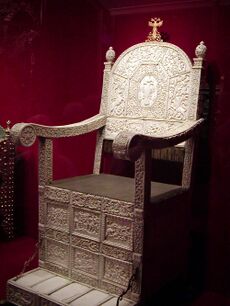
By the 16th century, the Russian ruler had emerged as a powerful, autocratic figure, a Tsar. By assuming that title, the sovereign of Moscow tried to emphasize that he was a major ruler or emperor (tsar (царь) represents the Slavic adaptation of the Roman Imperial title/name Caesar)[44] on a par with the Byzantine emperor. Indeed, after Ivan III married Sophia Palaiologina, the niece of the late Byzantine Emperor Constantine XI Palaiologos, in 1472, the Moscow court adopted Byzantine terms, rituals, titles, and emblems such as the double-headed eagle, which survives in the coat of arms of Russia.
At first, the Byzantine term autokrator expressed only the literal meaning of an independent ruler, but in the reign of Ivan IV (1533-1584) it came to imply unlimited (autocratic) rule. In 1547 the Grand Duke Ivan IV was crowned Tsar and thus was recognized – at least by the Russian Orthodox Church – as Emperor. Notably, the hegumen Philotheus of Pskov claimed in 1510 that after Constantinople fell to the Ottoman Empire in 1453, the Russian tsar remained the only legitimate Orthodox ruler, and that Moscow was the Third Rome, becoming the final lineal successor to Rome and Constantinople; these were the two centers of Christianity and of the Roman empires (Western and Eastern) of earlier periods. The "Third Rome" concept would resonate in the self-image of the Russian people in future centuries.
بداية عهد إيڤان الرابع
Muscovy remained a fairly unknown society in Western Europe until Baron Sigismund von Herberstein published his Rerum Moscoviticarum Commentarii (literally Notes on Muscovite Affairs) in 1549. This provided a broad view of what had been a rarely visited and poorly reported state. In the 1630s, the Russian Tsardom was visited by Adam Olearius, whose lively and well-informed writings were soon translated into all the major languages of Europe.
Further information about Russia was circulated by English and Dutch merchants. One of them, Richard Chancellor, sailed to the White Sea in 1553 and continued overland to Moscow. Upon his return to England, the Muscovy Company was formed by himself, Sebastian Cabot, Sir Hugh Willoughby, and several London merchants. Ivan IV used these merchants to exchange letters with Elizabeth I.
Despite the domestic turmoil of the 1530s and 1540s, Russia continued to wage wars and to expand. It grew from 2.8 to 5.4 million square kilometers from 1533 to 1584.[45] Ivan defeated and annexed the Khanate of Kazan on the middle Volga in 1552 and later the Astrakhan Khanate, where the Volga meets the Caspian Sea. These victories transformed Russia into a multiethnic and multiconfessional state, which it continues to be today. The tsar now controlled the entire Volga River and gained access to Central Asia.
Expanding to the northwest toward the Baltic Sea proved to be much more difficult. In 1558, Ivan invaded Livonia, eventually involving himself in a twenty-five-year war against the Polish–Lithuanian Commonwealth, Sweden, and Denmark. Despite first successes, Ivan's army was pushed back, and the nation failed to secure a coveted position on the Baltic Sea.
Hoping to make profit from Russia's concentration on Livonian affairs, Devlet I Giray of Crimea, accompanied by as many as 120,000 horsemen, repeatedly devastated the Moscow region, until the Battle of Molodi put a stop to such northward incursions. But for decades to come, the southern borderland was annually pillaged by the Nogai Horde and the Crimean Khanate, who took local inhabitants with them as slaves. Tens of thousands of soldiers protected the Great Abatis Belt — a burden for a state whose social and economic development was stagnating.
Foreign policies of Ivan IV
Muscovy remained a fairly unknown society in Western Europe until Baron Sigismund von Herberstein published his Rerum Moscoviticarum Commentarii (literally Notes on Muscovite Affairs) in 1549. This provided a broad view of what had been a rarely visited and poorly reported state. In the 1630s, the Russian Tsardom was visited by Adam Olearius, whose lively and well-informed writings were soon translated into all the major languages of Europe.
Further information about Russia was circulated by English and Dutch merchants. One of them, Richard Chancellor, sailed to the White Sea in 1553 and continued overland to Moscow. Upon his return to England, the Muscovy Company was formed by himself, Sebastian Cabot, Sir Hugh Willoughby, and several London merchants. Ivan IV used these merchants to exchange letters with Elizabeth I.
Despite the domestic turmoil of the 1530s and 1540s, Russia continued to wage wars and to expand. It grew from 2.8 to 5.4 million square kilometers from 1533 to 1584.[46] Ivan defeated and annexed the Khanate of Kazan on the middle Volga in 1552 and later the Astrakhan Khanate, where the Volga meets the Caspian Sea. These victories transformed Russia into a multiethnic and multiconfessional state, which it continues to be today. The tsar now controlled the entire Volga River and gained access to Central Asia.
Expanding to the northwest toward the Baltic Sea proved to be much more difficult. In 1558, Ivan invaded Livonia, eventually involving himself in a twenty-five-year war against the Polish–Lithuanian Commonwealth, Sweden, and Denmark. Despite first successes, Ivan's army was pushed back, and the nation failed to secure a coveted position on the Baltic Sea.
Hoping to make profit from Russia's concentration on Livonian affairs, Devlet I Giray of Crimea, accompanied by as many as 120,000 horsemen, repeatedly devastated the Moscow region, until the Battle of Molodi put a stop to such northward incursions. But for decades to come, the southern borderland was annually pillaged by the Nogai Horde and the Crimean Khanate, who took local inhabitants with them as slaves. Tens of thousands of soldiers protected the Great Abatis Belt — a burden for a state whose social and economic development was stagnating.
Late reign of Ivan IV and oprichnina
During the late 1550s, Ivan developed a hostility toward his advisers, the government, and the boyars. Historians have not determined whether policy differences, personal animosities, or mental imbalance caused his wrath. In 1565, he divided Russia into two parts: his private domain (or oprichnina) and the public realm (or zemshchina). For his private domain, Ivan chose some of the most prosperous and important districts of Russia. In these areas, Ivan's agents attacked boyars, merchants, and even common people, summarily executing some and confiscating land and possessions. Thus began a decade of terror in Russia that culminated in the Massacre of Novgorod (1570).
As a result of the policies of the oprichnina, Ivan broke the economic and political power of the leading boyar families, thereby destroying precisely those persons who had built up Russia and were the most capable of administering it. Trade diminished, and peasants, faced with mounting taxes and threats of violence, began to leave Russia. Efforts to curtail the mobility of the peasants by tying them to their land brought Russia closer to legal serfdom. In 1572, Ivan finally abandoned the practices of the oprichnina.
According to a popular theory,[بحاجة لمصدر][ممن؟] the oprichnina was started by Ivan in order to mobilize resources for the wars and to quell opposition. Regardless of the reason, Ivan's domestic and foreign policies had a devastating effect on Russia and led to a period of social struggle and civil war, the Time of Troubles (Smutnoye vremya, 1598–1613).
زمن الشدائد
 مقالة مفصلة: زمن الشدائد
مقالة مفصلة: زمن الشدائد
[[ File:Ryabushkin ruswoman church.JPG|thumb|250px|Andrei Ryabushkin. Muscovite women at the church service.]]

فتح سيبيريا
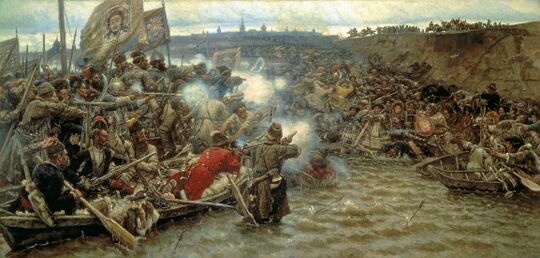
Russia's eastward expansion encountered little resistance. In 1581, the Stroganov merchant family, interested in the fur trade, hired a Cossack leader, Yermak Timofeyevich, to lead an expedition into western Siberia. Yermak defeated the Khanate of Sibir and claimed the territories west of the Ob and Irtysh Rivers for Russia.
From such bases as Mangazeya, merchants, traders, and explorers pushed eastward from the Ob River to the Yenisei River, then on to the Lena River and the coast of the Pacific Ocean. In 1648, Cossack Semyon Dezhnyov opened the passage between America and Asia. By the middle of the 17th century, Russians had reached the Amur River and the outskirts of the Chinese Empire.
After a period of conflict with the Qing dynasty, Russia made peace with China in 1689. By the Treaty of Nerchinsk, Russia ceded its claims to the Amur Valley, but it gained access to the region east of Lake Baikal and the trade route to Beijing. Peace with China strengthened the initial breakthrough to the Pacific that had been made in the middle of the century.
آل رومانوڤ
Legal code of 1649

فتح سيبريا

Early Imperial Russia
Key texts
- Grigory Kotoshikhin's Russia during the reign of Alexey Mikhailovich (1665) is the indispensable source for those studying administration of the Russian tsardom
- Domostroy is a 16th-century set of rules regulating everyday behaviour in the Russian boyar families.
المصادر
- ^ أ ب Population of Russia. Tacitus.nu (30 August 2008). Retrieved on 2013-08-20.
- ^ History of Russia. [Vol. 2, Pg. 10] Academia.edu (28 December 2010). Retrieved on 24.04.21.
- ^ Population and Territory of Russia 1646-1917. Warconflict.ru (2014). Retrieved on 24.04.21.
- ^ Хорошкевич, А. Л. Символы русской государственности. -М. :Изд-во МГУ,1993. -96 с. :ил., фот. ISBN 5-211-02521-0
- ^ Костомаров Н. И. Русская история в жизнеописаниях ее главнейших деятелей. Olma Media Group, 2004 [1]
- ^ Зимин А. А., Хорошкевич А. Л. Россия времени Ивана Грозного. Москва, Наука, 1982
- ^ Перевезенцев, С. В. Смысл русской истории, Вече, 2004
- ^ Monahan, Erika (2016). "Russia: 3. Tsardom of Muscovy (1547-1721)". The Encyclopedia of Empire. pp. 1–6. doi:10.1002/9781118455074.wbeoe425. ISBN 9781118455074.
- ^ Magocsi, Paul R. (2010). A History of Ukraine: The Land and Its Peoples. University of Toronto Press. p. 223. ISBN 978-1-4426-1021-7. Retrieved 19 أغسطس 2016.
- ^ Б. М. Клосс. О происхождении названия “Россия”. М.: Рукописные памятники Древней Руси, 2012. С. 3
- ^ Б. М. Клосс. О происхождении названия “Россия”. М.: Рукописные памятники Древней Руси, 2012. С. 13
- ^ E. Hellberg-Hirn. Soil and Soul: The Symbolic World of Russianness. Ashgate, 1998. P. 54
- ^ Lawrence N. Langer. Historical Dictionary of Medieval Russia. Scarecrow Press, 2001. P. 186
- ^ Б. М. Клосс. О происхождении названия “Россия”. М.: Рукописные памятники Древней Руси, 2012. С. 30-38
- ^ Б. М. Клосс. О происхождении названия “Россия”. М.: Рукописные памятники Древней Руси, 2012. С. 55-56
- ^ Б. М. Клосс. О происхождении названия “Россия”. М.: Рукописные памятники Древней Руси, 2012. С. 61
- ^ Б. М. Клосс. О происхождении названия “Россия”. М.: Рукописные памятники Древней Руси, 2012. С. 57
- ^ Robert Auty, Dimitri Obolensky. Companion to Russian Studies: Volume 1: An Introduction to Russian History. Cambridge University Press, 1976. P. 99
- ^ "Чин венчания на царство Ивана IV Васильевича. Российский государственный архив древних актов. Ф. 135. Древлехранилище. Отд. IV. Рубр. I. № 1. Л. 1-46". Archived from the original on 23 يناير 2019. Retrieved 2 ديسمبر 2016.
- ^ Lee Trepanier. Political Symbols in Russian History: Church, State, and the Quest for Order and Justice. Lexington Books, 2010. P. 61: "so your great Russian Tsardom, more pious than all previous kingdoms, is the Third Rome"
- ^ Barbara Jelavich. Russia's Balkan Entanglements, 1806-1914. Cambridge University Press, 2004. P. 37. Note 34: "Since the first Rome fell through the Appollinarian heresy and the second Rome, which is Constantinople, is held by the infidel Turks, so then thy great Russian Tsardom, pious Tsar, which is more pious than previous kingdoms, is the third Rome"
- ^ أ ب Richard S. Wortman. Scenarios of Power: Myth and Ceremony in Russian Monarchy from Peter the Great to the Abdication of Nicholas II. Princeton University Press, 2013. P. 17
- ^ Maija Jansson. England and the North: The Russian Embassy of 1613-1614. American Philosophical Society, 1994. P. 82: "...the towns of our great Russian Tsardom", "all the people of all the towns of all the great Russian Tsardom".
- ^ Walter G. Moss. A History of Russia Volume 1: To 1917. Anthem Press, 2003. P. 207
- ^ Readings for Introduction to Russian civilization, Volume 1. Syllabus Division, University of Chicago Press, 1963. P. 253
- ^ Hans Georg Peyerle, George Edward Orchard. Journey to Moscow. LIT Verlag Münster, 1997. P. 47
- ^ William K. Medlin. Moscow and East Rome: A Political Study of the Relations of Church and State in Muscovite Russia. Delachaux et Niestl, 1952. P. 117: Addressing Patriarch Jeremiah, Tsar Feodor Ivanovich declares, "We have received the sceptre of the Great Tsardom of Russia to support and to watch over our pious and present Great Russian Tsardom and, with God's grace".
- ^ Шмидт С. О. Памятники письменности в культуре познания истории России. М., 2007. Т. 1. Стр. 545
- ^ Felicity Stout. Exploring Russia in the Elizabethan commonwealth: The Muscovy Company and Giles Fletcher, the elder (1546-1611). Oxford University Press. 2015
- ^ Jennifer Speake (editor). Literature of Travel and Exploration: An Encyclopedia. Routledge. 2014. P. 650
- ^ Marshall Poe (editor). Early exploration of Russia. Volume 1. Routledge. 2003
- ^ John T. Shawcross. John Milton: The Self and the World. University Press of Kentucky, 2015. P. 120
- ^ Milton, John. A brief history of Moscovia and of other less-known countries lying eastward of Russia as far as Cathay, gather'd from the writings of several eye-witnesses
- ^ Б. М. Клосс. О происхождении названия “Россия”. М.: Рукописные памятники Древней Руси, 2012. С. 4
- ^ Ruslan G. Skrynnikov. Reign of Terror: Ivan IV. BRILL. 2015. P. 189
- ^ Кудрявцев, Олег Фёдорович. Россия в первой половине XVI в: взгляд из Европы. Русский мир, 1997. [2]
- ^ Тихвинский, С. Л., Мясников, В. С. Восток—Россия—Запад: исторические и культурологические исследования. Памятники исторической мысли, 2001 — С. 69
- ^ Хорошкевич А. Л. Русское государство в системе международных отношений конца XV—начала XVI в. — М.: Наука, 1980. — С. 84
- ^ Sigismund von Herberstein. Rerum Moscoviticarum Commentarii. Synoptische Edition der lateinischen und der deutschen Fassung letzter Hand. Basel 1556 und Wien 1557. München, 2007. P. 29
- ^ Advertissement au Lecteur // Jacques Margeret. Estat de l'empire de Russie et grande duché de Moscovie, avec ce qui s'y est passé de plus mémorable et tragique... depuis l'an 1590 jusques en l'an 1606 en septembre, par le capitaine Margeret. M. Guillemot, 1607. Modern French-Russian edition: Маржерет Ж. Состояние Российской империи (Тексты, комментарии, статьи). Ж. Маржерет в документах и исследованиях. Серия: Studia historica М. Языки славянской культуры. 2007. С. 46, 117
- ^ Vernadsky V. Moscow Tsardom. in 2 v. Moscow: Agraph, 2001 (Russian)
- ^ "В некотором царстве, в некотором государстве..." Sigurd Schmidt, Doctor of history sciences, academician of RAN, Journal "Rodina", Nr. 12/2004 Archived 29 أكتوبر 2007 at the Wayback Machine
- ^ О великом и славном Российском Московском государстве. Гл. 50 // Арсеньев Ю. В. Описание Москвы и Московского государства: По неизданному списку Космографии конца XVII века. М, 1911. С. 6-17 (Зап. Моск. археол. ин-та. Т. 11)
- ^ قالب:OEtymD)
- ^ Richard Pipes, Russia under the old regime, p. 80
- ^ Richard Pipes, Russia under the old regime, p. 80
| Muscovy
]].- This article contains material from the Library of Congress Country Studies, which are United States government publications in the public domain. - روسيا
- Jarmo Kotilane, Marshall Poe (ed.), Modernizing Muscovy: Reform and Social Change in Seventeenth Century Russia, Routledge, 2004, ISBN 0-415-30751-1
- Short description is different from Wikidata
- Use dmy dates from October 2016
- Articles containing روسية-language text
- Pages using infobox country or infobox former country with the flag caption or type parameters
- Pages using infobox country or infobox former country with the symbol caption or type parameters
- Pages using Lang-xx templates
- Articles with hatnote templates targeting a nonexistent page
- Articles containing لاتينية-language text
- Articles with unsourced statements from October 2015
- Articles with specifically marked weasel-worded phrases from October 2015
- تاريخ روسيا
- بلدان سابقة في اوروبا
- مطلع التاريخ المعاصر حسب البلد



